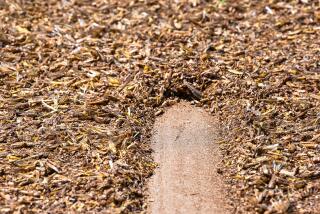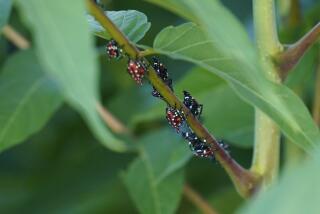Tree-Keepers Ready Defenses for Invasion of Gypsy Moth
- Share via
HAGERSTOWN, Md. — As the insects sleep, snug in their egg masses, forest managers are marshaling forces to battle what is expected to be Maryland’s biggest infestation of gypsy moth caterpillars in at least six years.
They are begging money and charting a strategy for spraying pesticides this spring on 50,000 acres, mainly in western Maryland from Garrett County to the forests around Camp David.
The voracious black worms defoliated 23,231 acres of oak trees and other hardwoods in the state last year, a nearly twentyfold increase from 1999. Michigan, New Jersey, Ohio, Pennsylvania, Virginia and West Virginia also saw an increase in defoliation.
Gypsy moths have been frustrating U.S. entomologists since around 1870, when they arrived in Massachusetts from Europe and began spreading. Their territory now ranges as far south as North Carolina and as far west as Michigan.
The latest outbreak in Maryland, after three years of relatively light damage, surprised Robert Tichenor Jr., chief of forest pest management at the Maryland Department of Agriculture.
“That’s kind of a characteristic of them, that they seem to have pretty sudden population increases, but this was even more sudden than what’s typical of the gypsy moth,” he said.
The population explosion prompted the agency to request an additional $700,000 from the General Assembly for a spraying campaign that will likely cost $1.5 million to $1.7 million, Tichenor said.
One goal is to limit defoliation in areas such as Dan’s Mountain in Allegany County, where trees weakened by the bugs last year could be lost altogether.
“The second defoliation is going to be devastating to the trees,” Tichenor said.
In Catoctin National Park, home to the Camp David presidential retreat in northern Frederick County, Supt. Mel Poole is planning the first spraying campaign since 1990. He has mapped more than 1,000 acres where concentrations of the brownish egg masses are worrisome.
“If we were to get significant defoliation, that might present us with additional security concerns,” he said. “But the primary driver is that the gypsy moth is an alien species--it’s not native to our ecosystem--and it does cause significant defoliation in oak forests.”
Infestations tend to be cyclical--Maryland’s last outbreak peaked at 93,864 defoliated acres in 1995--and somewhat predictable. Scientists knew populations were growing but didn’t expect such a sudden increase.
Tichenor said the boom probably resulted from a combination of weather and other environmental conditions that favored survival of the larvae. Some scientists believe the drought of the two previous years may have slowed the growth of a fungus fatal to gypsy moths.
For whatever reason, Tichenor said, the fungus was less prevalent last year and more gypsy moth larvae survived.
He said that even if 99% of the larvae die, there are usually enough left to more than replace the previous generation.
“If you’ve got like 90% or 85% or 80% mortality, you’ve got a huge increase. It seems like it’s all of a sudden, but that potential to increase is always there,” he said.
Maryland, Michigan, New Jersey, Ohio, Pennsylvania, Virginia and West Virginia plan spraying campaigns from late April to early June. The forests earmarked for spraying total nearly 453,000 acres, an 80% percent increase over last year, said entomologist Amy Onken of the U.S. Forest Service’s Northeastern Research Station in Morgantown, W.Va.
The sprayed agents are a naturally occurring bacteria known as B.t. or a substance called Dimilin that prevents molting.
Homeowners can help by looking on the undersides of tree branches, beneath flaps of bark and under their eaves for the small, brownish-gray patches of egg masses, Tichenor said. They should be scraped off and buried or submerged in soapy water.
“Any egg mass destroyed is a little bit of help,” he said.
More to Read
Sign up for Essential California
The most important California stories and recommendations in your inbox every morning.
You may occasionally receive promotional content from the Los Angeles Times.













